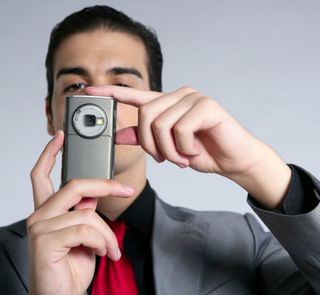What Determines A Good Phone Camera
What Really Makes a Good Cell Phone Camera?

The great megapixel race may finally be slowing down in digital cameras, merely it's picking up steam in prison cell phones.
In digital photography, the term "pixel" refers to the tiny dots that make up a photograph. The more pixels a photograph has, the college its epitome resolution. A megapixel is equal to one one thousand thousand pixels.
Both Samsung's Pixon 12 and Sony Ericsson'southward Satio cell phones take 12-megapixel photos—meaning you can now purchase cell phones with greater resolution than Canon'southward top-of-the-line point-and-shoot digital cameras.
If this sounds a little crazy, that's because it is, experts say. Few people need 12 megapixels, especially in a jail cell phone camera. The megapixel race has grown out of the megapixel myth, the false notion that a camera with college resolution is always better. Manufacturers and retailers, eager to convince consumers that they need the latest camera and phone models, have pushed this faulty idea difficult.
"By itself, the number of megapixels doesn't tell y'all anything about the quality of the prototype produced," said Steve Berardi, founder of PhotoNaturalist.cyberspace. "Sure, it will tell you lot how big the paradigm is, just bigger doesn't always mean better quality."
For the average shutterbug, five or six megapixels is probably plenty of resolution. Beyond this level, various other camera characteristics, such equally the size of the image sensor and eyes quality, are more important than raw megapixels.
Canon acknowledged this in digital cameras when information technology released the latest entry in its Powershot series in 2009. The company's PowerShot G11 has only a 10-megapixel image sensor, which is nigh 5 megapixels less than the previous model, the PowerShot G10. Despite the lower megapixel count, many photographers say the G11 takes cleaner and less grainy images compared to the G10.
The megapixel myth holds fifty-fifty less water for jail cell phones than it does for stand-alone digital cameras similar the G11. Near folks, afterward all, aren't making big prints out of their jail cell-phone photos or enlarging small sections—activities for which ultra-high resolution comes in handy.
As with the early days of digital cameras, the quality of cell telephone photos is improving. But higher megapixel counts are probable not the main reason why, Berardi told TechNewsDaily.
"Information technology's probably considering they're using amend [image] sensors, or just larger ones."
Mike Evans, editor of the cell-phone review and word site MobileMentalism.com, said that fifty-fifty though cell phone manufacturers keep ratcheting upwardly the megapixels, they are also emphasizing other of import camera features, such as autofocus, prototype stabilization for less blurry photos, a xenon or dual LED wink, and good eyes.
"In item, the Sony Ericsson Satio and Samsung Pixon 12 are camera phones with bully camera-related features other than megapixels," Evans said.
- How to Have Meliorate Cell Phone Photographs
- 7 Gadgets That Changed the Globe
- Americans Are Info-Junkies
Source: https://www.livescience.com/6112-good-cell-phone-camera.html
Posted by: muhammadreepeemsess.blogspot.com

0 Response to "What Determines A Good Phone Camera"
Post a Comment